Through late January 2015, the Old Farmers Almanac’s winter forecast looked like it might be a fail in Boston because of heat.
The Almanac had predicted a cold, dry winter. Though a November storm piled 88 inches of snow on parts of upstate New York and brought a severe cold snap to New England, Boston’s winter had mostly been abnormally warm. December 2014 was the
warmest on record, with temperatures nearly 4 degrees above normal. The city’s snowfall total was
60 percent less than normal. Only one short cold snap at the beginning of January suggested it was really winter.
[caption id="attachment_19651" align="alignright" width="300"]
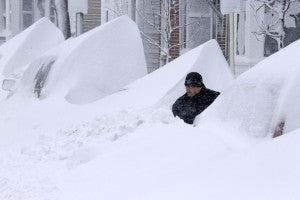
That's a lot of snow... - via The Weather Network[/caption]
That changed January 24. In less than four weeks, five storms dumped almost 8 feet of snow, obliterating records. Two of the storms were among the ten largest recorded. The eventual season total was 110.6 inches of snow, a record and almost 44 inches above average. The arctic weather brought arctic chill. The temperature didn’t hit 40 degrees from January 20 through March 3,
another record.
The month-long hammering began January 24 with a storm that, compared to the ones to follow, was nothing much. However, it was the heaviest snow seen that winter, dropping about 5 inches. Even while it was clearing, weather models were predicting a monster snowfall three days later.
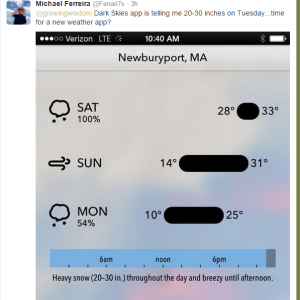
While New England residents took forecasts seriously, at that point they were understandably more than a little skeptical about
how much snow was coming. David Epstein, a meteorologist who blogs daily about the weather for Boston.com, received this tweet from a reader.
“Dark Skies app is telling me 20-30 inches in Tuesday…time for a new weather app?”
The skepticism was understandable: one weather model predicted that the January 24 storm would drop 12 inches on the ground,
Epstein said, and not the less than half that actually fell.
By January 25, New England residents knew they were in for a major Nor’easter. The National Weather Service issued a blizzard warning and forecasters were talking up the possibility of a top 10 storm for accumulation and warning about possible flooding.
The storm,
which The Weather Channel named Juno, lived up to its warnings.
During the January 27-28 storm, coastal Massachusetts saw flood water 4 feet above normal. After the storm, Sandwich, Mass.
condemned more than a dozen flooded homes. Nantucket, Mass, reported a wind gust of 78 miles per hour. Parts of Massachusetts received 3 feet of snow, and the total at Boston’s Logan Airport was 24.4 inches, making it
Boston’s sixth-largest recorded storm.
For the most part, if their homes weren’t damaged, people seemed to just enjoy themselves. The Boston Globe had tips for working at home and a Netflix playlist for snowed-in residents. The Boston Yeti
introduced itself on Twitter stalking the streets and hailing a cab in Somerville, Mass., two miles northwest of Boston.
Andrew Thimmig, who lived in Somerville, said he spent most of the day shoveling.
“We shoveled the car then had to shovel our way back to the door. It was just very, very time consuming and exhausting,” he said.
They didn’t even have time to start shoveling out before the next named storm,
Winter Storm Linus, blew in starting February 1.
[caption id="attachment_19658" align="alignright" width="300"]
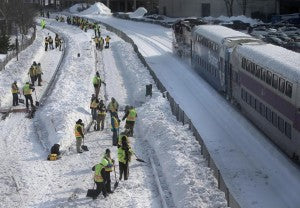
via Boston Globe[/caption]
It dropped another foot of snow and again caused major transportation problems. Flights in and out of Logan Airport were canceled. The Massachusetts Bay Transit Authority warned of major delays because of trouble keeping tracks clear. Kids were excited: school was canceled February 2 and 3,
the fifth and sixth snow days of the year.
Even a celebration for the New England Patriots’ Super Bowl win got
pushed back two days.
And a third storm was on its way. Winter Storm Marcus became another top-ten-ever storm when it piled another 23.8 inches of snow on Logan Airport February 7-10.
At this point, transportation problems were bringing the city to a standstill.
Boston Mayor Marty Walsh announced at the beginning of the storm that the city had already used its $18 million snow removal budget.
"We've never seen snow like this in the history of our city,"
he said in a press conference, according to a story from The Weather Channel.
The transit authority shut down rail service for February 11.
Thimmig said, though the line he rode stayed open, in some areas the transit authority couldn’t keep up with snow accumulation. Communities organized people to help shovel the tracks, he said.
“It was a huge fiasco,” he said.
City leaders talked about borrowing snow melting equipment from New York City. Thimmig said his office never had a snow day. Now, it was closed for about 10 days. Those who could work from home did so.
“I got to spend more time at home with my wife, which was probably the best part. If I could, I’d work. If the network was down, my wife and I would watch TV – as long as we had internet. I’d go out periodically and shovel. On the days I did have to work, my wife would shovel, because at the time she was between jobs,” he said.
Court cases, including the one for the Boston Marathon bomber,
were rescheduled.
People were getting snow-weary, as
Boston Globe writer Charlotte Wilder expressed in her column, “
A Breakup Letter to Snow.”
“It’s like you’ve turned into this unstoppable monster. I don’t even know you anymore. You’ve also ruined a lot of my stuff; I can’t find like five-thousand of my cars, my bikes are all buried for the foreseeable future, and you’ve killed every single plant I had,” she wrote.
Little did they know. Another heavy winter storm, named Neptune, brought yet another round of heavy snow and deep freeze to New England on February 15-16.
[caption id="attachment_19650" align="alignright" width="300"]
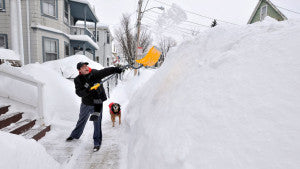
Nowhere to throw the snow - via The Weather Network[/caption]
At this point, the region was buried under more than six feet of snow. Snow removal was becoming problematic. Piles in the mall parking lot near Thimmig’s home were 10 feet tall.
“They took it out of town in big dump trucks because there was nowhere to put it,” he said.
When he shoveled, he just tossed the snow in the street for the snowplows because his yard was so full.
Sidewalks were covered, and those that weren’t were icy.
“I had to walk along the side of the road while trucks and larger vehicles would go by. It was a little bit of a fun game,” Thimmig said.
[caption id="attachment_19652" align="alignright" width="300"]
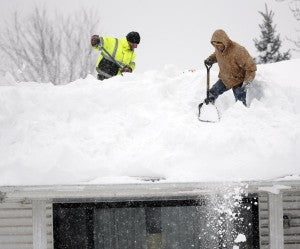
Too much snow can collapse your roof - via Boston Globe[/caption]
Homes with flat roofs were in danger and more than 70 collapsed under the snow’s weight. Thimmig said his office sustained some damage, but overall he and his neighbors were fortunate. A tree got knocked over in his neighborhood and a fallen branch hit a truck. He never lost power but buildings and traffic signals nearby did. His neighbor’s rain gutter broke off.
“That was very alarming, to wake up about two in the morning to a loud crash outside our window,” he said.
The deep freeze that followed brought the lowest temperature of the season: -3 degrees Fahrenheit, on February 16.
Yet another named storm, Pandora, brought more snow and ice on February 22. On March 15, another couple of inches fell, enough for the National Weather Service in Boston to announce that 2014-2015 was
the snowiest season in Boston’s recorded history. The city finished with
110.6 inches.
It took a long time to get out. One woman wasn’t able to dig her car out
until March 23. The last of the snow piles
didn’t melt until July 15.
Thimmig, who since moved from the Boston metro area, learned several things about being prepared for a bad winter. First, have an emergency preparedness kit with food and tools on hand. He recommended buying multiple snow shovels beforehand, “because one of them will probably break.”
“We got snow equipment, but we didn’t expect it to be that bad,” he said.
Ready.gov has winter preparedness checklists with supplies and to-do lists.
That might be useful for New England. Some forecasts are
predicting this winter might be snowy too.
While we remember last year's snowy winter, let us not forget to prepare for the next one.
Take a moment to look over your winter prep. Are you ready for another winter?

 That's a lot of snow... - via The Weather Network[/caption]
That changed January 24. In less than four weeks, five storms dumped almost 8 feet of snow, obliterating records. Two of the storms were among the ten largest recorded. The eventual season total was 110.6 inches of snow, a record and almost 44 inches above average. The arctic weather brought arctic chill. The temperature didn’t hit 40 degrees from January 20 through March 3, another record.
The month-long hammering began January 24 with a storm that, compared to the ones to follow, was nothing much. However, it was the heaviest snow seen that winter, dropping about 5 inches. Even while it was clearing, weather models were predicting a monster snowfall three days later.
That's a lot of snow... - via The Weather Network[/caption]
That changed January 24. In less than four weeks, five storms dumped almost 8 feet of snow, obliterating records. Two of the storms were among the ten largest recorded. The eventual season total was 110.6 inches of snow, a record and almost 44 inches above average. The arctic weather brought arctic chill. The temperature didn’t hit 40 degrees from January 20 through March 3, another record.
The month-long hammering began January 24 with a storm that, compared to the ones to follow, was nothing much. However, it was the heaviest snow seen that winter, dropping about 5 inches. Even while it was clearing, weather models were predicting a monster snowfall three days later.
 While New England residents took forecasts seriously, at that point they were understandably more than a little skeptical about how much snow was coming. David Epstein, a meteorologist who blogs daily about the weather for Boston.com, received this tweet from a reader.
“Dark Skies app is telling me 20-30 inches in Tuesday…time for a new weather app?”
The skepticism was understandable: one weather model predicted that the January 24 storm would drop 12 inches on the ground, Epstein said, and not the less than half that actually fell.
By January 25, New England residents knew they were in for a major Nor’easter. The National Weather Service issued a blizzard warning and forecasters were talking up the possibility of a top 10 storm for accumulation and warning about possible flooding.
The storm, which The Weather Channel named Juno, lived up to its warnings.
During the January 27-28 storm, coastal Massachusetts saw flood water 4 feet above normal. After the storm, Sandwich, Mass. condemned more than a dozen flooded homes. Nantucket, Mass, reported a wind gust of 78 miles per hour. Parts of Massachusetts received 3 feet of snow, and the total at Boston’s Logan Airport was 24.4 inches, making it Boston’s sixth-largest recorded storm.
For the most part, if their homes weren’t damaged, people seemed to just enjoy themselves. The Boston Globe had tips for working at home and a Netflix playlist for snowed-in residents. The Boston Yeti introduced itself on Twitter stalking the streets and hailing a cab in Somerville, Mass., two miles northwest of Boston.
Andrew Thimmig, who lived in Somerville, said he spent most of the day shoveling.
“We shoveled the car then had to shovel our way back to the door. It was just very, very time consuming and exhausting,” he said.
They didn’t even have time to start shoveling out before the next named storm, Winter Storm Linus, blew in starting February 1.
[caption id="attachment_19658" align="alignright" width="300"]
While New England residents took forecasts seriously, at that point they were understandably more than a little skeptical about how much snow was coming. David Epstein, a meteorologist who blogs daily about the weather for Boston.com, received this tweet from a reader.
“Dark Skies app is telling me 20-30 inches in Tuesday…time for a new weather app?”
The skepticism was understandable: one weather model predicted that the January 24 storm would drop 12 inches on the ground, Epstein said, and not the less than half that actually fell.
By January 25, New England residents knew they were in for a major Nor’easter. The National Weather Service issued a blizzard warning and forecasters were talking up the possibility of a top 10 storm for accumulation and warning about possible flooding.
The storm, which The Weather Channel named Juno, lived up to its warnings.
During the January 27-28 storm, coastal Massachusetts saw flood water 4 feet above normal. After the storm, Sandwich, Mass. condemned more than a dozen flooded homes. Nantucket, Mass, reported a wind gust of 78 miles per hour. Parts of Massachusetts received 3 feet of snow, and the total at Boston’s Logan Airport was 24.4 inches, making it Boston’s sixth-largest recorded storm.
For the most part, if their homes weren’t damaged, people seemed to just enjoy themselves. The Boston Globe had tips for working at home and a Netflix playlist for snowed-in residents. The Boston Yeti introduced itself on Twitter stalking the streets and hailing a cab in Somerville, Mass., two miles northwest of Boston.
Andrew Thimmig, who lived in Somerville, said he spent most of the day shoveling.
“We shoveled the car then had to shovel our way back to the door. It was just very, very time consuming and exhausting,” he said.
They didn’t even have time to start shoveling out before the next named storm, Winter Storm Linus, blew in starting February 1.
[caption id="attachment_19658" align="alignright" width="300"] via Boston Globe[/caption]
It dropped another foot of snow and again caused major transportation problems. Flights in and out of Logan Airport were canceled. The Massachusetts Bay Transit Authority warned of major delays because of trouble keeping tracks clear. Kids were excited: school was canceled February 2 and 3, the fifth and sixth snow days of the year.
Even a celebration for the New England Patriots’ Super Bowl win got pushed back two days.
And a third storm was on its way. Winter Storm Marcus became another top-ten-ever storm when it piled another 23.8 inches of snow on Logan Airport February 7-10.
At this point, transportation problems were bringing the city to a standstill. Boston Mayor Marty Walsh announced at the beginning of the storm that the city had already used its $18 million snow removal budget.
"We've never seen snow like this in the history of our city," he said in a press conference, according to a story from The Weather Channel.
The transit authority shut down rail service for February 11.
Thimmig said, though the line he rode stayed open, in some areas the transit authority couldn’t keep up with snow accumulation. Communities organized people to help shovel the tracks, he said.
“It was a huge fiasco,” he said.
City leaders talked about borrowing snow melting equipment from New York City. Thimmig said his office never had a snow day. Now, it was closed for about 10 days. Those who could work from home did so.
“I got to spend more time at home with my wife, which was probably the best part. If I could, I’d work. If the network was down, my wife and I would watch TV – as long as we had internet. I’d go out periodically and shovel. On the days I did have to work, my wife would shovel, because at the time she was between jobs,” he said.
Court cases, including the one for the Boston Marathon bomber, were rescheduled.
People were getting snow-weary, as Boston Globe writer Charlotte Wilder expressed in her column, “A Breakup Letter to Snow.”
“It’s like you’ve turned into this unstoppable monster. I don’t even know you anymore. You’ve also ruined a lot of my stuff; I can’t find like five-thousand of my cars, my bikes are all buried for the foreseeable future, and you’ve killed every single plant I had,” she wrote.
Little did they know. Another heavy winter storm, named Neptune, brought yet another round of heavy snow and deep freeze to New England on February 15-16.
[caption id="attachment_19650" align="alignright" width="300"]
via Boston Globe[/caption]
It dropped another foot of snow and again caused major transportation problems. Flights in and out of Logan Airport were canceled. The Massachusetts Bay Transit Authority warned of major delays because of trouble keeping tracks clear. Kids were excited: school was canceled February 2 and 3, the fifth and sixth snow days of the year.
Even a celebration for the New England Patriots’ Super Bowl win got pushed back two days.
And a third storm was on its way. Winter Storm Marcus became another top-ten-ever storm when it piled another 23.8 inches of snow on Logan Airport February 7-10.
At this point, transportation problems were bringing the city to a standstill. Boston Mayor Marty Walsh announced at the beginning of the storm that the city had already used its $18 million snow removal budget.
"We've never seen snow like this in the history of our city," he said in a press conference, according to a story from The Weather Channel.
The transit authority shut down rail service for February 11.
Thimmig said, though the line he rode stayed open, in some areas the transit authority couldn’t keep up with snow accumulation. Communities organized people to help shovel the tracks, he said.
“It was a huge fiasco,” he said.
City leaders talked about borrowing snow melting equipment from New York City. Thimmig said his office never had a snow day. Now, it was closed for about 10 days. Those who could work from home did so.
“I got to spend more time at home with my wife, which was probably the best part. If I could, I’d work. If the network was down, my wife and I would watch TV – as long as we had internet. I’d go out periodically and shovel. On the days I did have to work, my wife would shovel, because at the time she was between jobs,” he said.
Court cases, including the one for the Boston Marathon bomber, were rescheduled.
People were getting snow-weary, as Boston Globe writer Charlotte Wilder expressed in her column, “A Breakup Letter to Snow.”
“It’s like you’ve turned into this unstoppable monster. I don’t even know you anymore. You’ve also ruined a lot of my stuff; I can’t find like five-thousand of my cars, my bikes are all buried for the foreseeable future, and you’ve killed every single plant I had,” she wrote.
Little did they know. Another heavy winter storm, named Neptune, brought yet another round of heavy snow and deep freeze to New England on February 15-16.
[caption id="attachment_19650" align="alignright" width="300"] Nowhere to throw the snow - via The Weather Network[/caption]
At this point, the region was buried under more than six feet of snow. Snow removal was becoming problematic. Piles in the mall parking lot near Thimmig’s home were 10 feet tall.
“They took it out of town in big dump trucks because there was nowhere to put it,” he said.
When he shoveled, he just tossed the snow in the street for the snowplows because his yard was so full.
Sidewalks were covered, and those that weren’t were icy.
“I had to walk along the side of the road while trucks and larger vehicles would go by. It was a little bit of a fun game,” Thimmig said.
[caption id="attachment_19652" align="alignright" width="300"]
Nowhere to throw the snow - via The Weather Network[/caption]
At this point, the region was buried under more than six feet of snow. Snow removal was becoming problematic. Piles in the mall parking lot near Thimmig’s home were 10 feet tall.
“They took it out of town in big dump trucks because there was nowhere to put it,” he said.
When he shoveled, he just tossed the snow in the street for the snowplows because his yard was so full.
Sidewalks were covered, and those that weren’t were icy.
“I had to walk along the side of the road while trucks and larger vehicles would go by. It was a little bit of a fun game,” Thimmig said.
[caption id="attachment_19652" align="alignright" width="300"] Too much snow can collapse your roof - via Boston Globe[/caption]
Homes with flat roofs were in danger and more than 70 collapsed under the snow’s weight. Thimmig said his office sustained some damage, but overall he and his neighbors were fortunate. A tree got knocked over in his neighborhood and a fallen branch hit a truck. He never lost power but buildings and traffic signals nearby did. His neighbor’s rain gutter broke off.
“That was very alarming, to wake up about two in the morning to a loud crash outside our window,” he said.
The deep freeze that followed brought the lowest temperature of the season: -3 degrees Fahrenheit, on February 16.
Yet another named storm, Pandora, brought more snow and ice on February 22. On March 15, another couple of inches fell, enough for the National Weather Service in Boston to announce that 2014-2015 was the snowiest season in Boston’s recorded history. The city finished with 110.6 inches.
It took a long time to get out. One woman wasn’t able to dig her car out until March 23. The last of the snow piles didn’t melt until July 15.
Thimmig, who since moved from the Boston metro area, learned several things about being prepared for a bad winter. First, have an emergency preparedness kit with food and tools on hand. He recommended buying multiple snow shovels beforehand, “because one of them will probably break.”
“We got snow equipment, but we didn’t expect it to be that bad,” he said.
Ready.gov has winter preparedness checklists with supplies and to-do lists.
That might be useful for New England. Some forecasts are predicting this winter might be snowy too.
While we remember last year's snowy winter, let us not forget to prepare for the next one.
Take a moment to look over your winter prep. Are you ready for another winter?
Too much snow can collapse your roof - via Boston Globe[/caption]
Homes with flat roofs were in danger and more than 70 collapsed under the snow’s weight. Thimmig said his office sustained some damage, but overall he and his neighbors were fortunate. A tree got knocked over in his neighborhood and a fallen branch hit a truck. He never lost power but buildings and traffic signals nearby did. His neighbor’s rain gutter broke off.
“That was very alarming, to wake up about two in the morning to a loud crash outside our window,” he said.
The deep freeze that followed brought the lowest temperature of the season: -3 degrees Fahrenheit, on February 16.
Yet another named storm, Pandora, brought more snow and ice on February 22. On March 15, another couple of inches fell, enough for the National Weather Service in Boston to announce that 2014-2015 was the snowiest season in Boston’s recorded history. The city finished with 110.6 inches.
It took a long time to get out. One woman wasn’t able to dig her car out until March 23. The last of the snow piles didn’t melt until July 15.
Thimmig, who since moved from the Boston metro area, learned several things about being prepared for a bad winter. First, have an emergency preparedness kit with food and tools on hand. He recommended buying multiple snow shovels beforehand, “because one of them will probably break.”
“We got snow equipment, but we didn’t expect it to be that bad,” he said.
Ready.gov has winter preparedness checklists with supplies and to-do lists.
That might be useful for New England. Some forecasts are predicting this winter might be snowy too.
While we remember last year's snowy winter, let us not forget to prepare for the next one.
Take a moment to look over your winter prep. Are you ready for another winter?


